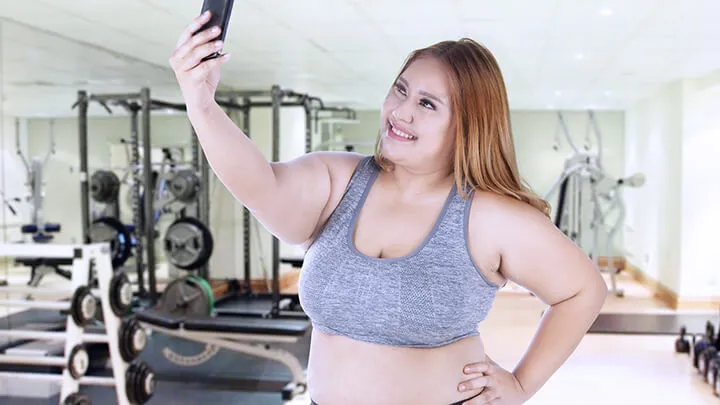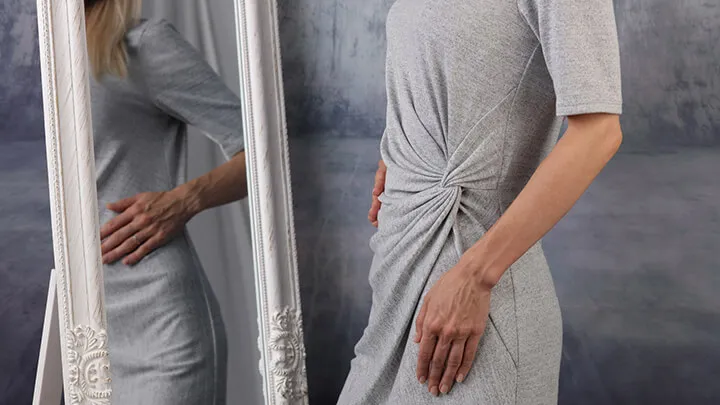
- Share on Facebook15
- Share on Pinterest
- Share on Twitter
Oh, the scale. It can be your best friend or sworn enemy when you’re trying to lose weight. From the sliding weight bar style used at the doctor’s office (seriously, what is up with that thing?) to the even more terrifying one on full display at seemingly every grocery store in America, there is nothing worse than stepping onto one and immediately praying it’s your shoes and underwear that have caused the needle to move in the wrong direction.
The scale makes us depressed
Unfortunately, so many of us fall prey to the vicious cycle of weighing ourselves, not seeing the number we hoped for and becoming depressed. However, we fail to remember that the human body is a complex organism that is constantly in flux. On any given day, our weight can change simply based on what we’ve had to eat or drink, how much bodily fluid we’ve expelled (among other things), whether or not we’ve exercised, the temperature outside, the list goes on and on.
If all we’re ever doing to measure progress is following an ever-changing number, we’re never going to feel satisfied with ourselves and be motivated to continue. Now, that’s not to say that having a weight loss goal isn’t a good idea. On the contrary, a baseline number of what you’d like to weigh can be very helpful in setting weight loss goals (for example, resolving to be under 200 pounds or aiming to drop 50 pounds). But it should not be the only thing you strive for.
Don’t believe me? Test it out yourself. Weigh yourself first thing in the morning and then right before bed. Chances are, you’ve put on a few pounds — even if you didn’t do anything that would warrant such weight gain. So, how can you track your progress without using a scale? Here are a few of my tried-and-true methods.
How do your clothes fit?
This is my absolute go-to for determining how I’m feeling and how I’m looking. I call it, “the skinny jeans test.” It’s simple: put on a pair of your favorite pants (or skirt, or dress) and notice any differences you may have in how they fit and feel. There are definitely times of the month where I have to wiggle myself into my jeans and other times where they slide up and button easily. From there, I scale my diet and exercise routine accordingly.
Now, this method, much like the number on the scale, can and will fluctuate as most of the supposed weight gain is usually just bloating brought on by travel, excessively salty foods and PMS. If I’m feeling particularly “stuffed” in my clothes, I make sure to incorporate more warm lemon water into my morning routine (great for detoxifying the body and jumpstarting your metabolism) and more high-intensity workouts (bring on the sweat!).
I’ll also add more leafy greens into my diet and limit my intake of dairy. I also make sure not to beat myself up over it — especially if this happens right after an indulgent weekend or a vacation. I’d rather allow myself to enjoy that extra slice of pizza and work harder later, than live in a constant state of limitations.
Take progress pictures

Once you embark on your fitness and wellness journey, chances are, you’re going to see results a lot slower than those around you. Think about it: you look at yourself in mirrors and reflections multiple times every day, so gradual changes will not be visible to your naked eye.
You know what will make an impact? Taking pictures of yourself on day one, then again on day 14, day 28 and so on. Once you start comparing photos of how you’re changing over the course of a month and then a few months, you’ll be so encouraged you won’t even care what the scale says — because you’re actually seeing the weight loss with your own eyes, not through a number.
A few tips for taking successful progress photos: consistent attire is a must, preferably something that can show off a majority of your body such as a bathing suit or sports bra and shorts. Remember, these photos are for your private viewing so don’t get hung up on picking the most perfect outfit. Just be sure that whatever you wear in your first photos, you’re able to continue wearing in all photos after that.
Key lighting is another important factor as you’ll want to be able to see your body in bright lighting and that way you can track your changes over time without having them be affected by shadows. Lastly, if possible, employ the help of someone you trust to take the photos so you are able to shoot from all angles. This could feel uncomfortable the first few times you shoot, but I promise, once you start getting close to your fitness goals, you’ll be much more comfortable showing off.
Measure yourself
Go back to basics with one of the oldest ways to measure weight loss without a scale. Grab a standard measuring tape to measure the changes in your body’s circumference and the areas where you are losing the most weight.
The top areas to measure are waist, hips, stomach, upper legs (thigh area) and upper arms (bicep area). Record these measurements along with your progress pictures. Remember: don’t measure as often as you take photos, as changes won’t be visible over shorter periods of time. A good rule of thumb is to track your measurements every four to six weeks.
How do you feel?
This is arguably the most important indicator of weight loss: how you actually feel in your body. Notice changes in your movements, energy levels and overall mood. Are you able to walk farther than before without getting tired? Have you noticed a decrease in aches and pains? How about your attitude and the way you interact with those around you? Chances are, if you’ve seen and felt these changes, you are losing weight.
One of the most important factors in losing weight is the direct impact it will have in changing so many aspects of your life. Once you feel better in your own skin, that positive energy will radiate to those around you. Additionally, as you lose weight and build muscle, you’ll see improvements in your physical activity. Is climbing the stairs no longer leaving you breathless and with knee pain? Are you able to run around with your kids and play for longer? Congratulations, those are way bigger achievements than dropping those last five pounds.
Stick to your goals and celebrate small achievements

At the end of the day, whether you are choosing to lose weight for health reasons or just plain vanity (which is perfectly fine), keep in mind that a number on the scale or the size of your jeans will not make you a better person.
The best way to care for yourself is by loving your body and wanting to keep it healthy. It’s easy to compare yourself to those around you and get discouraged if you don’t see changes happening as quickly as you’d like, so make sure to celebrate the small wins. This can be opting for a salad over a burger for lunch, choosing to take the stairs instead of the elevator or running for five minutes straight when you could only make it for two minutes before. Whatever it is, be proud of the fact that you resolved to make a change in the first place.
Sometimes the first step is the hardest. If you’ve decided to embark on a journey to a new you, be proud and reward yourself along the way — even if that means with chocolate.
— Megan Harris
- Share on Facebook15
- Share on Pinterest
- Share on Twitter

